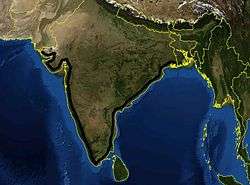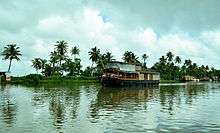Coastal India





Coastal India is a Geo-cultural region in the Indian Subcontinent that spans the entire coastline of India.
Region
Coastal India spans from the south west Indian coastline along the Arabian sea from the coastline of the Gulf of Kutch in its western most corner and stretches across the Gulf of Khambhat, and through the Salsette Island of Mumbai along the Konkan and southwards across the Raigad region and through Kanara and further down through Mangalore and along the Malabar through Cape Comorin in the southernmost region of South India with coastline along the Indian Ocean and through the Coromandal Coast or Cholamandalam Coastline on the South Eastern Coastline of the Indian Subcontinent along the Bay of Bengal through the Utkala Kalinga region until the easternmost Corner of shoreline near the Sunderbans in Coastal East India.
People
The people along coastal India exhibit vast diversity along an underlying commonality as a result of its coastal topography and sea trade between west Asian Mediterranean traders along its vast coastline. The region includes Gujaratis in the western most region, Kannadigas, Tuluvas, Goans and Maharashtrians along the Konkan coast or the western coastline, Malayalis in its southern most region of South India, the Tamilians along southern Cholamandalam coast, the Telugus and Oriya people along the South eastern coast through Utkala Kalinga region along the Coromandal coast, and the Bengali people along the easternmost coastline along the Bay of Bengal.
Thriving Sea Trade and intermingling
A thriving trade existed between the Mediterranean world and Coastal Indian regions [1][2][3][4] This led to significant intermingling between the people of Coastal India and the west asian world, particularly along the South West Indian Coastline along the Arabian Sea. Several west Asian communities have also settled and become part of the diversity of coastal south west India. These include the Parsis,[5] Bohras [6] and Baghdadi Jews [7] in the western most region, the Bene Israel along the South western region, the descendants of mediterranean traders along Coorg and Mangalore, the Jonakan Mappilas [8] along Malabar region, and the cochin jews [1][2][3][8][9][10][11] and Syriac Nasranis [1][2][3][8][9][10][11] along the Southern most region of South India. The Chola Empire established vast Tamil influence across South East Asian region [12][13][14] across Indonesia, Java, Bali and Sumatra. This brought South Indian Heritage to Cambodia, Indonesia and Bali where the Balinese Hindu traditions still thrives. This also lead to intermingling between coastal India and the south east Asia particularly in the South eastern Cholamandalam coastline along the Bay of Bengal.
Heritage
The linguistic diversity of Coastal India includes languages of the Dravidian language family including Malayalam, Tamil, Telugu, Tulu and Kannada; languages belonging to the western zone of Indo Iranian langiage families including Gujarati, Marathi, Konkani, languages belonging to the central zone of the Indo-Iranian language families including Urdu and Persian and languages belonging to the eastern zone of Indo Iranian language family including Oriya and Bengali. The region also has speakers of Semitic languages like Arabic, Hebrew and Aramaic. The common elements of the people of coastal India includes cuisine that consists of agrarian and coastal products and clothing that involves long flowing drapes with bare midriff for both men and women suited for humid and warm climate.[15] Throughout coastal India women wear drapes called saree in various styles.[15] In the western corner of the region the drapes are called as Dhoti for men.[15] and Chaniya choli for women,[15] further southwards the drapes are called as lungi or mundu for men.[15] and veshti for women.[15] Women experience relatively more role in social system as compared to non coastal peninsular India and enjoy significantly more prominence in society than non coastal non peninsular India.[15][16][17][18] Towards the southernmost tip of coastal south western India the social system was considerably more matri-focal.[15][16][17][18][19] This is also manifested in feminine deity oriented festivals and rituals celebrating Shakti or feminine power [20] like Navratri festival among the Gujarati People, Thiruvathira festival among the Malayali people and the Durga Puja of the Bengali People.
Gallery
-
Bekalfort beach in Kerala
-

Beach in Mumbai, Maharashtra
-
Beach in Visakhapatnam, Andhra Pradesh
-

Kettuvellam vembanad lake, Kerala
-
Sunrise at Kanyakumari, Tamil Nadu
References
- 1 2 3 Bjorn Landstrom (1964) "The Quest for India", Double day English Edition, Stockholm.
- 1 2 3 Miller, J. Innes. (1969). The Spice Trade of The Roman Empire: 29 B.C. to A.D. 641. Oxford University Press. Special edition for Sandpiper Books. 1998. ISBN 0-19-814264-1.
- 1 2 3 Thomas Puthiakunnel, (1973) "Jewish colonies of India paved the way for St. Thomas", The Saint Thomas Christian Encyclopedia of India, ed. George Menachery, Vol. II., Trichur.
- ↑ Periplus Maris Erythraei "The Periplus of the Erythraean Sea", (trans). Wilfred Schoff (1912), reprinted South Asia Books 1995 ISBN 81-215-0699-9
- ↑ Hodivala, S. (1920), Studies in Parsi History, Bombay
- ↑ The Dawoodi Bohras: an anthropological perspective, by Shibani Roy. Published by B.R. Publishing, 1984.
- ↑ Sargon, J(1987) 'Baghdadi Jews of India and the Sassoons' in Jewish Daily Israel Today, Perspectiv/Opinion; Tuesday august 25th
- 1 2 3 Bindu Malieckal (2005) Muslims, Matriliny, and A Midsummer Night's Dream: European Encounters with the Mappilas of Malabar, India; The Muslim World Volume 95 Issue 2
- 1 2 Koder S. 'History of the Jews of Kerala". The St. Thomas Christian Encyclopaedia of India, Ed. G. Menachery,1973.
- 1 2 Leslie Brown, (1956) The Indian Christians of St. Thomas. An Account of the Ancient Syrian Church of Malabar, Cambridge: Cambridge University Press 1956, 1982 (repr.)
- 1 2 Menachery G (1973) The St. Thomas Christian Encyclopedia of India, Ed. George Menachery, B.N.K. Press, vol. 2, ISBN 81-87132-06-X, Lib. Cong. Cat. Card. No. 73-905568; B.N.K. Press
- ↑ K.A. Nilakanta Sastri, K.A (1984) [1935]. The CōĻas. Madras: University of Madras.
- ↑ Keay, John. India: A History. New Delhi: Harper Collins Publishers. ISBN 0-00-255717-7.
- ↑ Hermann, Kulke; Rothermund D (2001) [2000]. A History of India. Routledge. ISBN 0-415-32920-5.
- 1 2 3 4 5 6 7 8 Boulanger, Chantal; (1997) Saris: An Illustrated Guide to the Indian Art of Draping, Shakti Press International, New York. ISBN 0-9661496-1-0
- 1 2 Craddock, Norma. 1994. Anthills, Split Mothers, and Sacrifice: Conceptions of Female Power in the Mariyamman Tradition. Dissertation, U. of California, Berkeley.
- 1 2 Trawick, Margaret. 1990a. Notes on Love in a Tamil Family. Berkeley: U. of California Press.
- 1 2 Wadley, Susan, ed. 1980. The Powers of Tamil Women. Syracuse: Syracuse U. Press.
- ↑ Smith R.T. (2002) Matrifocality, in International encyclopedia of the social and behavioral sciences (eds) Smelser & Baltes, vol 14, pp 9416.
- ↑ Dikshitar, V. R. Ramachandra, The Lalita Cult, Motilal Banarsidass Publishers Pvt. Ltd. (Delhi, 1942, 2d ed. 1991, 3d ed. 1999).